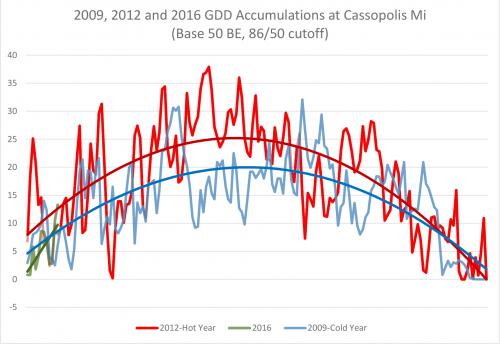Planting corn in wet conditions – is it worth it?
Is it better to plant corn into wet conditions and get it in the ground, or wait?
Do I plant corn now or wait for drier field conditions? That is the million dollar question that most involved in agriculture here are asking. I usually look to Purdue University corn agronomist Robert Nielsen for some insight into this challenge. Indiana has lived through some tough, wet planting conditions in relatively recent years. Nielsen’s famously described “crappy” planting conditions have been seen all too often in the Hoosier state, and the impacts from trafficking the field and planting when it is too wet, well, can be really bad. They include things like causing excess compaction and sidewall smearing of the seed channel, both of which can impact root development and subsequent plant access to nutrients and soil moisture. Tillage in wet conditions or planting no-till on wet fields can also directly impact seed to soil contact, either by interfering with seed channel closure or because clod formation does not allow for a good seedbed. All of these factors can impact final plant stands or increase stand unevenness, and each of these can cause lowering of yield potential.
Soil type will remain a critical consideration. Lighter textured soils will drain faster and provide a much more forgiving seedbed than heavier soils, or those with higher organic matter content (with the possible exception of straight muck). Since many of our fields have various soil types in them, it may be a good year to pick out areas in fields that can be planted first and patch in the rest.
There is a reason, of course, that we like to plant corn in late April or early May. The key growth component factors that we gain with timely planting include heat unit accumulation and solar radiation capture potential. Other things that might be impacted by a planting delay include higher chances for heat/drought stress during key growth stages, especially pollination. Irrigation can certainly help to offset drought risk on fields with systems.
The month of May can account for 15 percent of the growing degree-days (GDD) available in the growing season (around 350 out of 2,500) in southwest Michigan. The first half of May usually contributes around 150 GDD, which is enough to get the corn up and out of the ground. The later planted corn usually emerges more quickly, and there is some compression of the growth stages. Dry-down can be another important factor with delayed planting.
Yield losses can be a little harder to nail down. Very little corn yield reduction per day is expected between May 1 and May 10. That steps up to about a bushel per day between May 10 and May 20. By June 1, that number rises to around three bushels per day, according to University of Wisconsin-Extension research conducted by Joe Laurer in 1997 and Gaska in 2000).
How fast corn grows during the season is closely associate with heat unit accumulation. While yield potential is not entirely based on GDDs, warmer than normal years can help plants to close the gap in crop growth and development caused by late planting. We have seen some fairly significant swings in growing conditions over the last decade in Michigan. The Michigan State University Enviro-weather stations have given us the data to look at the GDD accumulations in the coldest growing season in a long time (2009) and the warmest (2012). The darker color trend line approximates the median GDD accumulations for each of these growing seasons, taking out the peaks and valleys in the temperature data. You can see that there is around a 5-GDD-per-day difference between the two extreme years in the month of July at the Cassopolis Enviro-weather station.
The outlooks from NOAA continue to show Michigan in a warmer than normal pattern throughout the 2016 growing season. If that is true, it may help to mitigate some, but not all, of the yield risk associated with late-planted corn.

2009, 2012 and 2016 GDD accumulations at Cassopolis, Michigan (base 50 BE, 86/50 cutoff).



 Print
Print Email
Email